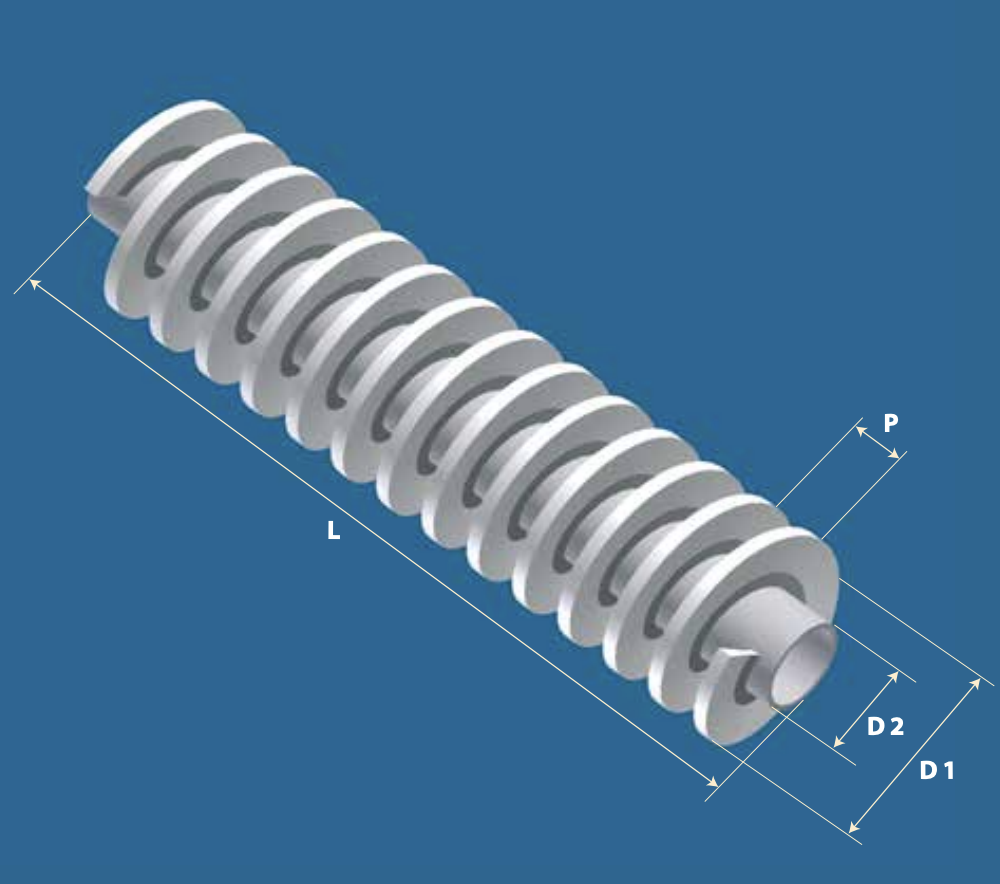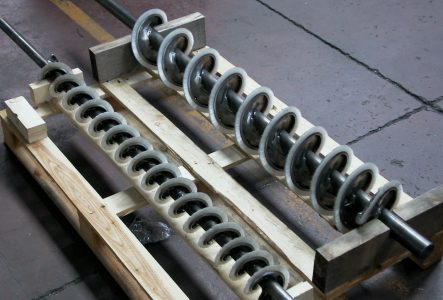Spiral strip brushes
Spiral strip brushes
Generalities
Winding a strip on a cylindrical metal core produces a spiral, which together forms a roller brush. If the spiral is removed from the metal core, a flexible (spring-like) brush called a ‘free spiral’ is obtained.
Spiral strip brushes are used for:
- high density rollers; very large rollers
- all-metal rollers for high temperatures
- auger brushes for material transport
- wide-pitch spirals for cleaning delicate surfaces
The spiral pitch P (see figure) is the parameter that most influences the density of the strip brush. A very dense brush is not always required, however. For example, if it has to remove debris and discharge it easily, the pitch will have to be large enough to prevent the debris from accumulating between the coils.
The minimum value of P coincides with that of the base B. The maximum value, on the other hand, is a function of the winding diameter D2: the larger D2 is, the larger the maximum pitch can be.
The following limits can be set: Pmin = B ; Pmax = D2

There is a minimum value of D2 below which the strip cannot be wound.
This limit value depends on the base B, and is shown in the table (galvanised iron base). For stainless steel bases, the values of D2 min in the table should be doubled. Regarding the maximum brush diameter D1, it is generally not possible to exceed D1=1000mm.
Winding diameter (mm)
| NASTRO SEMPLICE | |||||||||||||
|---|---|---|---|---|---|---|---|---|---|---|---|---|---|
| B | 5 | 6 | 8 | 10 | 13 | 14 | 17 | 20 | |||||
| D2 min | 15 | 20 | 25 | 25 | 90 | 90 | 160 | 160 |
In addition to defining the density of the brush, the winding pitch can be used to perform a mechanical transport function. If in fact P is large enough to contain all or part of the workpieces, the brush will behave like an auger, and the rotation will be associated with a transverse movement of the material. It is therefore important, in this case, to specify whether the winding should be right-handed or left-handed. Finally, there may be two spirals (left and right) converging at the centre of the brush, with the effect of conveying on the centreline or at both ends.
The brush-coclearance solution is particularly suitable for all those cases where particularly delicate material has to be transported and for the low noise level. To design an auger brush given the amount of product to be conveyed, the following formula is very useful.
If you want to move a flow of material V [l /min] with a brush rotating at n [rpm], you will have to maintain a winding pitch of at least
P ≥ (4,000,000 V) / (π n e (D1² – D2²)) + B [mm] Where e is the auger filling factor, with e close to 0 at an empty auger and e=1 at a full auger.

Another important fact to know at the design stage is the rotational speed at which a strip roller can be driven. Unfortunately, this depends not only on the materials, but also on the load on the brush and the filament-surface friction coefficient. It is therefore necessary to calculate the limiting speed from time to time based on the known parameters. In general, a roller strip brush can be said to have a higher limiting speed than a corresponding punched brush. We are available to provide you with the necessary project data.
In the case of high speeds, a sample must be made and tested under safe conditions.
Videos and images
GALLERY
Do you want to request an offer?
Are you interested in receiving more information and being contacted by one of our specialized operators?
Request your offer now

Do you want to request an offer?
Are you interested in receiving more information and being contacted by one of our specialized operators?
Request your offer now
Frequently asked questions
What is the advantage of using a brush instead of another deformable object?
The special feature of the brush is that the working surface consists of millions of individual elements, which are the ends of individual filaments.
This gives the brush an adaptability that no other element, however deformable, can have.
How much must the brush interfere with the workpiece?
It depends on various factors. In a nutshell, it can be said that 2 mm is a good compromise. The important thing is that the brush filaments work ‘on the tip’ and not on the side.
Can a bundle of filament be detached from the brush body?
Depending on the materials used and the dimensions, there is a limiting tensile load that an individual bundle can withstand.
Beyond this limit, the bundle comes off, so the brush must be calculated according to use. This limit can be greatly increased by constructing ‘sewn’ or ‘tied’ brushes by hand, where instead of a single anchoring element, a continuous steel wire is placed.
Is a punched brush or a strip cheaper?
There is no single answer. Speaking of e.g. cylindrical brushes, the strip brush is generally cheaper when the dimensions are large (e.g. over one metre in length). For small dimensions, punched brushes are certainly more suitable and convenient.
Is it possible for a single filament to slip out of the bundle and contaminate the product?
This can only happen if the brush has a manufacturing defect, like any other type of object (e.g. a roller made of silicone flakes, one of which is defective and breaks).
When it is important that no contamination occurs, synthetic (not natural) fibres with a diameter greater than or equal to 0.15 mm should be used.
What softness or hardness of brush can I achieve?
Practically all degrees of hardness are possible, from very soft to very hard. In fact, hardness is a combination of the filament diameter, its free length and the density of the bundles.
Is it possible to have a certified 'food grade' brush?
Of course, we can provide FDA or FOOD GRADE certification and filament traceability.
Is it possible to have an ATEX-certified brush?
Unfortunately not, as it is the machine + brush assembly that needs to be ATEX certified, not the brush alone.
However, it is possible to supply the materials that the certifier requires, e.g. conductive bases, conductive filaments, etc.
Is it possible to 'regenerate' a worn-out brush?
Generally speaking, it is possible, but one has to assess whether it is cost-effective, which is not always the case. In addition, in the case of a punched brush, it is inadvisable to regenerate the brush more than twice, so as not to reduce the tightness of the bundles.






